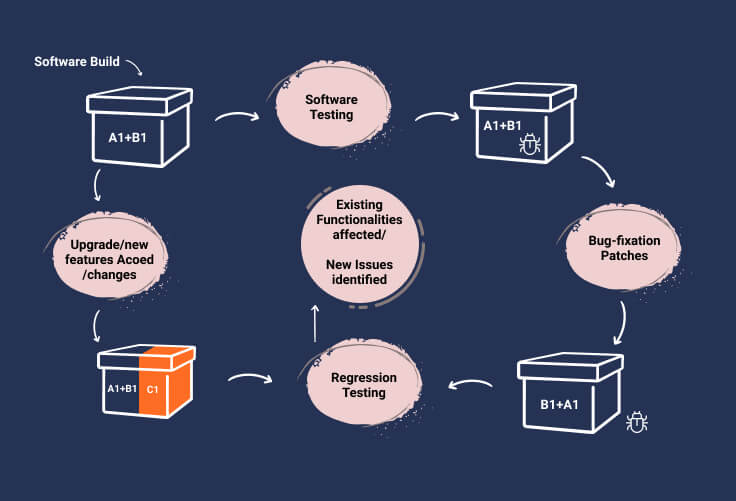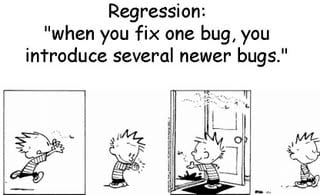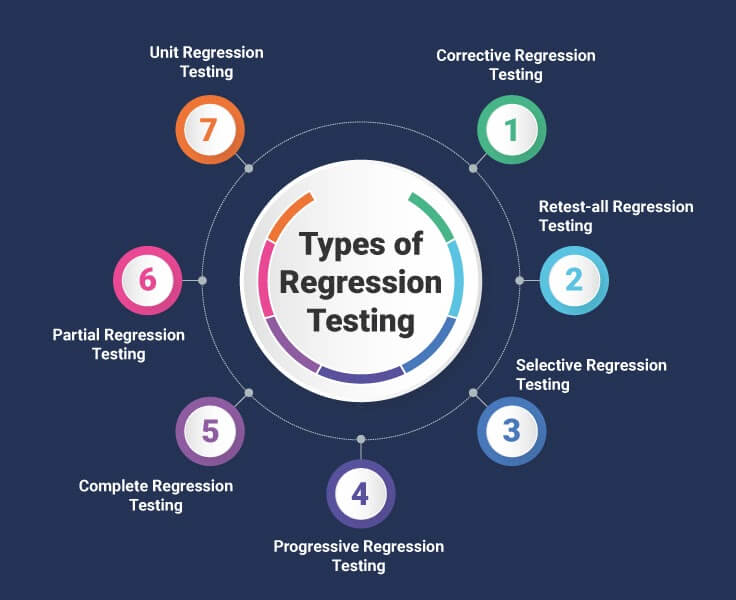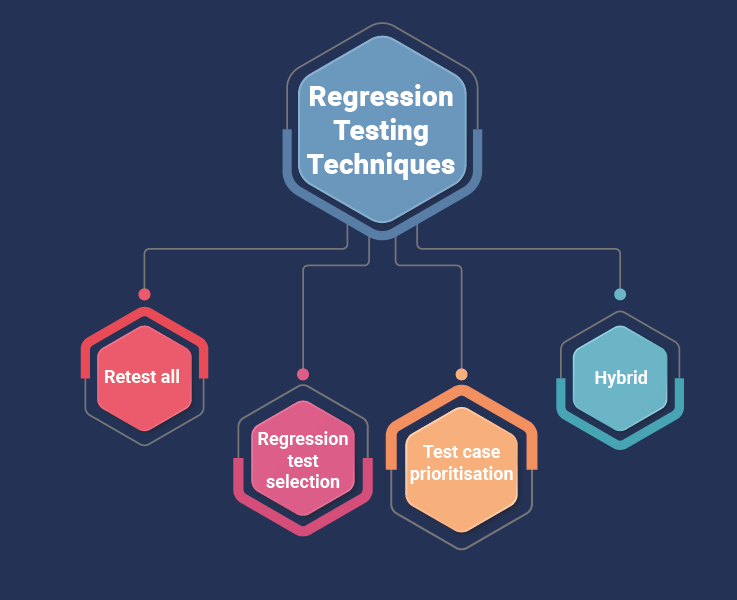- Example of Regression Testing
-
Why We Need Regression Testing?
- Types of Regression Testing
- How to do Regression Testing?
-
Selecting Test Cases For Regression Testing
-
Regression Testing Tools
-
Regression Testing and Configuration Management
-
Advantages of Regression Testing
-
Disadvantages of Regression Testing
- Difference Between Retesting and Regression Testing
-
The Takeaway
Regression Testing is a type of software testing done to check that a recent program or code change has not adversely impacted the existing functionality. It can be defined as a type of software testing used to verify the updates and changes in software without affecting the overall functionality of that software. For example, regression testing is performed when there is a code change in a software application.
In short, Regression Testing is nothing but re-execution of partial or complete already executed test cases. This is done to ensure that the functionality works fine after implementing the changes.
This testing is done to ensure that there are no side effects of new code on other functionalities. In addition, the user gets to ensure that the old code still works with the latest code changes.
If the tested software does not perform as expected after the change, it is called Software Regression.
Example of Regression Testing
Here we are going to have cases to understand the example of regression testing.
Example 1
Consider a Software application with multiple functionalities. Now, there are updates in the source code of that software application, and few changes occur. So after testing the updated changes, all the previously tested functionality needs to be tested again. Testers do it to verify that changes in the code have not affected the previous functionalities.
Regression Testing is not dependent upon any framework or development language. However, the user needs to verify that bug fixes and newly added features do not affect the previous version of the software.
Example 2

Consider that we have a software application with functionality: A1+B1. While testing that application, a bug gets identified. Bug-fixation processes, including few changes in the code, are being carried out to resolve the bug. However, some existing functionality of the software application also gets affected in the bug removal process: B1-A1. Thus, regression testing is carried out to check whether existing functionalities have been affected or not along with the detection of any new bug or issue in the event of changes and bug-fixation.
Further, we can also see that during the upgrade or addition of a new feature; C1, the existing functionalities of the application; A1+B1 have been impacted with the change in the functionality; A1*B1. Here, also regression tests are executed over software applications to find out whether existing functionalities have been affected or not.
This is the most basic example of regression testing. These regression test examples can be further elaborated depending upon the project and its requirement. Thus, you can have a more in-depth idea about the examples of regression testing.
Why We Need Regression Testing?

The need for regression testing arises when there is a code change, and we need to verify if the changed code affects the other areas of software application. However, regression testing is required when there are bug fixes and performance fixes as well.
Besides, software maintenance is an activity that includes enhancements, error corrections, optimization, and deletion of existing features. These modifications may cause the system to work incorrectly. Therefore, Regression Testing becomes necessary.
Types of Regression Testing
There are mainly seven types of regression testing. Let us explore each type of regression test in brief.

1. Corrective Regression Testing
Corrective Testing is a type of regression testing conducted when there is no change in the code. Moreover, it does not require any new test cases and takes lesser time in bug detecting. It is known for its repetitive use and convenience.
2. Retest-all Regression Testing
Retest-all Regression Testing is performed to check bugs in all areas, even when code changes are done only in certain software parts. Due to this, it is considered a time-consuming and tedious type of regression testing.
Retest-all Regression Testing is not at all suggested for minor changes in a software application or product. However, testers and clients usually consider this type of regression testing occasionally due to its comprehensive nature.
3. Selective Regression Testing
As its name suggests, Selective Regression Testing uses only selected modules from a test case. In this type of regression testing, there is no need to run a complete test. This regression test makes sure to use subsets of already existing test cases. Users can replace new code based on the requirement. It also reduces costs, efforts, and time required in the testing process.
4. Progressive Regression Testing
Progressive Regression Testing works well when there are only a few changes in the code. It is a good choice when the tester develops some new test cases. It helps the software tester to test work on updated functionality without compromising any previous features.
5. Complete Regression Testing
Complete Regression Testing examines the existing features and code before running any further testing. It is a type of regression testing in which the code goes through many changes. It can allow you to restore any change during the process.
Complete Regression Testing is a trustworthy and promising test. It is used as a standard software test due to its ability to find bugs quickly. It is the end test before delivering the software application or product to the client.
6. Partial Regression Testing
Partial Regression Testing is done when adding new code to an already existing piece of code. The basic idea of this type of regression testing is to ensure that the system works fine in the same way as it was before.
It is an essential part of regression testing. As it saves time and detects bugs accurately, it is also widely used by software testers.
7. Unit Regression Testing
According to experts, Unit Regression Testing is the essential type of regression testing. Whenever a code is manipulated in a unit, the tester runs all test scenarios.
Software Tester blocks all the interactions and dependencies while conducting the Unit Regression Testing. This test aims to deliver accurate and valuable units of code that add value to the end software. Usually, this test is performed by a Senior Software Tester.
Now that you are familiar with all the types of regression testing let’s look at how to do a regression test. We’ll also see the regression testing techniques involved in it.
How to do Regression Testing?
To do regression testing, you first need to identify the bugs. Then, required changes in the code are required in order to fix those bugs by software developers. The next step is to select the relevant test cases from the test suit. Finally, ensure that your chosen test cases cover both the affected and the modified part of the code.
To conduct effective regression testing, the testing team should develop a regression testing plan. This plan should consist of a regression testing strategy and exit criteria. Then Regression Testing is carried out with different techniques.
The regression testing techniques are as follows:
- Retest All
- Regression Test Selection
- Test Case Prioritization
- Hybrid

Retest All
Retest All is a regression testing method in which all the existing test cases in a bucket are re-executed. It is the most expensive regression testing technique as it requires a lot of resources and time.
Regression Test Selection
In this regression testing technique, selected test cases are executed from the test suit. The selection of these test cases is made based on code changes in the module.
Test cases are further split into two different categories. The first is a reusable test case that can be used in further regression cycles, and the other is an obsolete test case that can not be used in upcoming regression cycles.
Test Case Prioritization
Prioritize the test cases depending upon the business requirements, functionalities, and frequency. Test cases with the highest priority are the first to get executed. Thus, the test case prioritization technique will reduce the regression test suite.
Hybrid
The hybrid regression testing technique is a combination of test case prioritization and regression test selection. Rather than selecting the entire test suite, only selected test cases are re-executed based on the priority.
Selecting Test Cases For Regression Testing
When it comes to selecting a test case, most of the beginners are confused about how to select a test case in regression testing? Here is the solution to that problem.
A good number of defects occurring in the production environment are due to last-minute bug fixes. Hence, selecting test cases for regression testing is a crucial task. Here is the list of compelling test cases that you can use while performing the regression test.
- Test cases that have frequent defects
- Functionalities that are highly visible to the users
- Test cases that verify core features of the products
- Test cases for the features that are recently changed
- Integration test cases
- Complex test cases
- Test cases for boundary values
- A sample of successful test cases
- A selection of failed test cases
Regression Testing Tools
If your software undergoes frequent changes, then regression testing costs will be very high. In such cases, using manual testing can increase test time as well as costs. However, automated regression testing is an intelligent choice in such situations.
Automaton testing is an area where we can reduce the efforts by using automated regression testing tools. It is an efficient as well as time-saving method. At the same time, the extent of automation depends on the test cases that will remain re-usable over time.
Most of the regression testing tools available in the market are record and playback types. Selecting a proper testing tool is necessary to maintain the quality of software.
Here is the list of top regression testing tools:
- Selenium
- IBM Rational Functional Tester
- Micro Focus Unified Functional Testing (UFT)
- Watir
- SilkTest
- TimeShiftX
- Sahi Pro
These are the standard tools for functional and regression testing. Here is a brief about the list of the most famous regression testing tools.
Regression Testing and Configuration Management
Configuration management is crucial during regression testing. Especially in an agile environment where code changes are frequent. To have effective regression testing following management configurations must be observed:
- Code tested must be under the configuration management tool.
- No changes to code must be allowed during the test.
- Regression testing must be immune to developer changes.
- The tester must isolate the database, and no changes should be allowed in it.
Advantages of Regression Testing
Regression Testing plays a vital role in Software Testing Life Cycle (STLC). Skipping a regression test may become a threat to the credibility and reputation of the software. Here are the advantages of regression testing
- Regression Testing guarantees the continuity of business operations.
- It helps to identify bugs by catching undefined integrations between different modules.
- It supports the testing team to release software faster and with quality assurance.
- It detects any type of error in an application constantly.
- Automated Regression Testing shortens the Software Testing Life Cycle
- It helps to gain higher customer satisfaction.
- It ensures that fixes do not adversely impact the existing functionality.
- The cost of comprehensive testing minimizes by using automated regression testing.
- Regression testing helps implement continuous integration, which automatically executes when we add a new piece of code.
- Automated test scripts can be reused and save much time.
- Regression testing improves the overall product quality.
- It allows to detect and fix the bug before shipping a software product into the market.
Disadvantages of Regression Testing
Though Regression Testing is one of the essential testings, it has a few disadvantages. Here is the list of disadvantages of regression testing.
- Manual regression testing requires a lot of effort and time, and it is a complex process.
- Regression testing is needed to perform even for a slight code change.
- It needs to be performed with each agile sprint.
- Complex functionalities require huge regression test scripts.
- Determining the frequency of regression tests after every bug fix is complicated.
- It needs an accurate understanding of business requirements.
- The testing team needs adequate and frequent information on application and business requirements.
- Time and resource constraints are the most significant disadvantages of regression testing.
Difference Between Retesting and Regression Testing
Many people have difficulty understanding the difference between retesting and regression testing. Here we are going to look at the key differences between these two types of testing. But before we move to the difference between retesting and regression testing, let us understand retesting in brief.
Retesting
Retesting is a process to check those specific cases that are detected with bugs in the final execution. Generally, when software testers find bugs in any software application, they assign them to software developers to fix them. Then, software developers fix those bugs and give them back to software testers for verification. This process continues until every bug is fixed and is known as retesting.
Now that you understand both retesting and regression testing, let us dive into their key differences.
Regression Testing vs. Retesting
| Regression Testing | Re-testing |
| Regression Testing is performed for the passed test cases. | Retesting is performed only for failed test cases. |
| Regression testing checks for unexpected side effects. | Regression testing checks the direct fixes. |
| Regression Testing does not include defect verification. | Defect verification is a part of re- testing. |
| Regression testing is ideal for automation as test cases increase with time. | Retesting is not ideal for automation as test cases changes with time. |
| Regression testing is known as genetic testing. | Retesting is known as planned testing. |
| The purpose of regression testing is to check whether a recent code change has not affected the other existing features. | The goal of retesting is to check that failed test cases in final execution are fixed or not. |
| It involves the general area of software. | It involves the specific feature of the software. |
The Takeaway
Regression Testing is crucial for any software product or application. It ensures that the end product is delivered with high quality and accuracy. At the same time, the changes made in the software do not affect the existing functionality.
Many tools are available for automated regression testing in the market. However, one should select these tools based on the project requirements. It also requires experience and skills to test the software efficiently.
As a software testing expert, OpenXcell considers a project-specific ratio of automated and manual testing. It helps to reduce the cost of testing smartly and deliver a high-quality end product. Besides, outsourcing to us would be a perfect choice if testing seems an obstacle to you. Experts at OpenXcell are always ready to guide you. Please feel free to contact us and get a quote or a piece of advice for free. You can turn to OpenXcell for its world-class software testing services.
Note:- Please let us know your testing-related questions in the comment.








